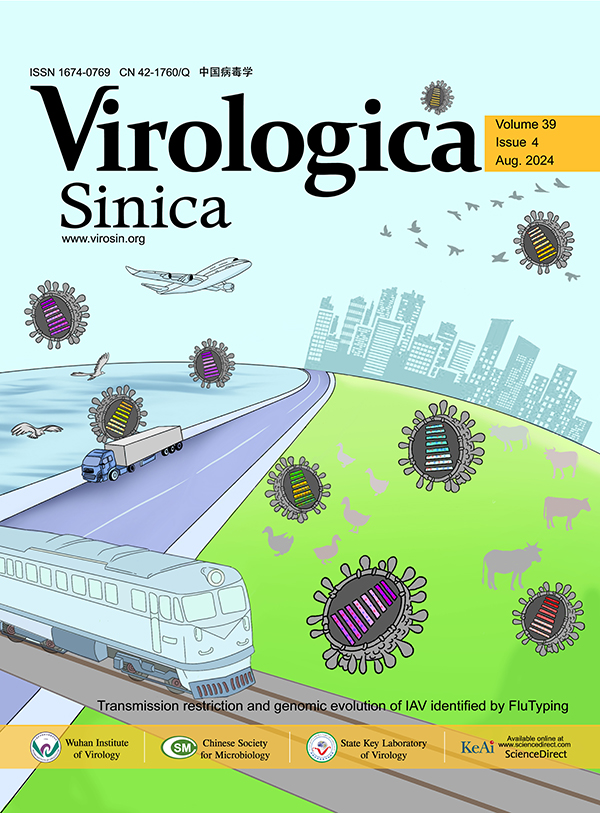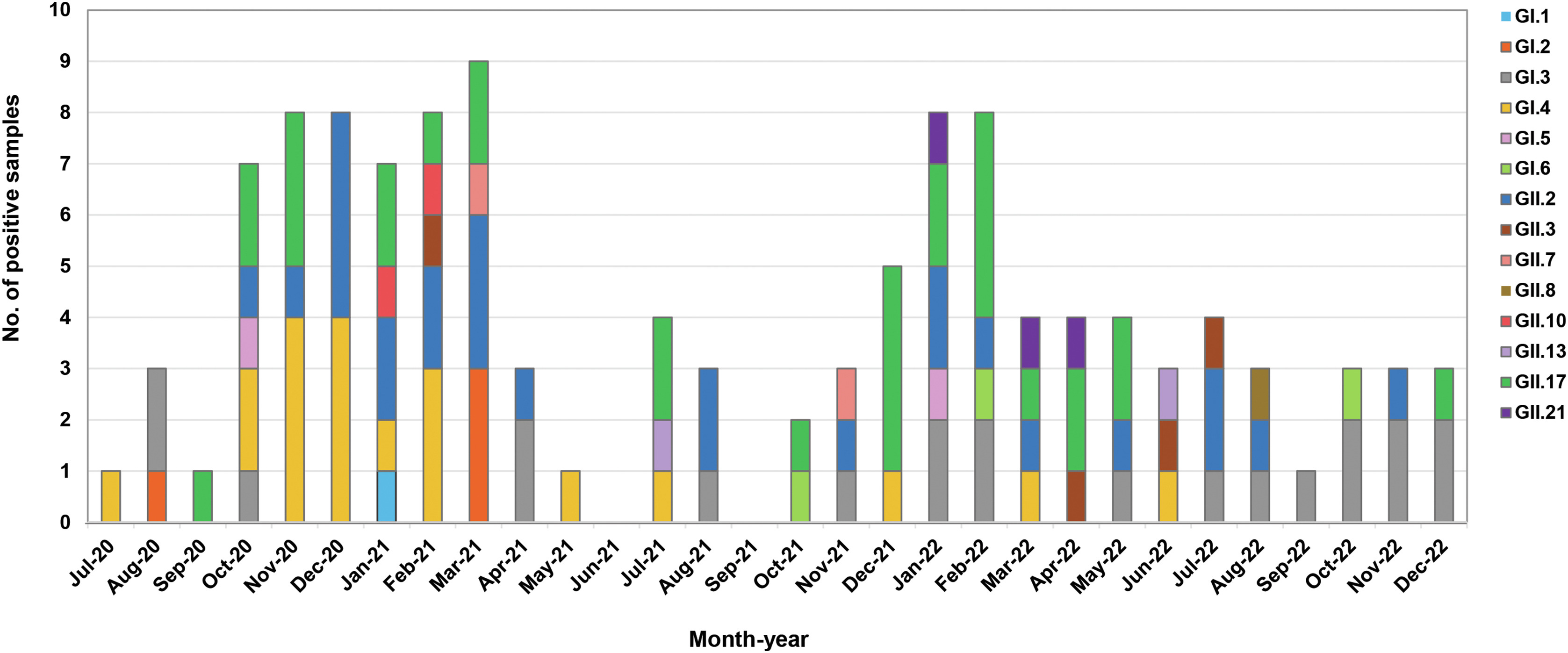-
Boonchan, M., Motomura, K., Inoue, K., Ode, H., Chu, P. Y., Lin, M., Iwatani, Y., Ruchusatsawat, K., Guntapong, R., Tacharoenmuang, R., Chantaroj, S., Tatsumi, M., Takeda, N., Sangkitporn, S., 2017. Distribution of norovirus genotypes and subtypes in river water by ultra-deep sequencing-based analysis. Lett. Appl. Microbiol. 65, 98-104.
-
Cannon, J. L., Barclay, L., Collins, N. R., Wikswo, M. E., Castro, C. J., Magana, L. C., Gregoricus, N., Marine, R. L., Chhabra, P., Vinje, J., 2017. Genetic and epidemiologic trends of norovirus outbreaks in the United States from 2013 to 2016 demonstrated emergence of novel GII.4 recombinant viruses. J. Clin. Microbiol. 55, 2208-2221.
-
Chhabra, P., de Graaf, M., Parra, G. I., Chan, M. C., Green, K., Martella, V., Wang, Q., White, P. A., Katayama, K., Vennema, H., Koopmans, M. P. G., Vinje, J., 2019. Updated classification of norovirus genogroups and genotypes. J. Gen. Virol. 100, 1393-1406.
-
da Silva, A. K., Le Saux, J. C., Parnaudeau, S., Pommepuy, M., Elimelech, M., Le Guyader, F. S., 2007. Evaluation of removal of noroviruses during wastewater treatment, using real-time reverse transcription-PCR: different behaviors of genogroups I and II. Appl. Environ. Microbiol. 73, 7891-7897.
-
Douglas, A., Sandmann, F. G., Allen, D. J., Celma, C. C., Beard, S., Larkin, L., 2021. Impact of COVID-19 on national surveillance of norovirus in England and potential risk of increased disease activity in 2021. J. Hosp. Infect. 112, 124-126.
-
Farahmand, M., Moghoofei, M., Dorost, A., Shoja, Z., Ghorbani, S., Kiani, S. J., Khales, P., Esteghamati, A., Sayyahfar, S., Jafarzadeh, M. et al., 2022. Global prevalence and genotype distribution of norovirus infection in children with gastroenteritis: A meta-analysis on 6 years of research from 2015 to 2020. Rev. Med. Virol. 32, e2237.
-
Haramoto, E., Katayama, H., Oguma, K., Yamashita, H., Tajima, A., Nakajima, H., Ohgaki, S., 2006. Seasonal profiles of human noroviruses and indicator bacteria in a wastewater treatment plant in Tokyo, Japan. Water. Sci. Technol. 54, 301-308.
-
Hoque, S. A., Kotaki, T., Pham, N. T. K., Onda, Y., Okitsu, S., Sato, S., Yuki, Y., Kobayashi, T., Maneekarn, N., Kiyono, H., Hayakawa, S., Ushijima, H., 2023a. Abundance of viral gastroenteritis before and after the emergence of COVID-19: molecular evidence on wastewater. J. Infect. 86, 154-225.
-
Hoque, S. A., Kotaki, T., Pham, N. T. K., Onda, Y., Okitsu, S., Sato, S., Yuki, Y., Kobayashi, T., Maneekarn, N., Kiyono, H., Hayakawa, S., Ushijima, H., 2023b. Genotype diversity of enteric viruses in wastewater amid the COVID-19 pandemic. Food. Environ. Virol. 15, 176-191.
-
Inoue, K., Motomura, K., Boonchan, M., Takeda, N., Ruchusatsawa, K., Guntapong, R., Tacharoenmuang, R., Sangkitporn, S., Chantaroj, S., 2016. Molecular detection and characterization of noroviruses in river water in Thailand. Lett. Appl. Microbiol. 62, 243-249.
-
Kageyama, T., Kojima, S., Shinohara, M., Uchida, K., Fukushi, S., Hoshino, F. B., Takeda, N., Katayama, K., 2003. Broadly reactive and highly sensitive assay for Norwalk-like viruses based on real-time quantitative reverse transcription-PCR. J. Clin. Microbiol. 41, 1548-1557.
-
Khamrin, P., Kumthip, K., Supadej, K., Thongprachum, A., Okitsu, S., Hayakawa, S., Ushijima, H., Maneekarn, N., 2017. Noroviruses and sapoviruses associated with acute gastroenteritis in pediatric patients in Thailand: increased detection of recombinant norovirus GII.P16/GII.13 strains. Arch. Virol. 162, 3371-3380.
-
Khamrin, P., Kumthip, K., Thongprachum, A., Sirilert, S., Malasao, R., Okitsu, S., Hayakawa, S., Ushijima, H., Maneekarn, N., 2020. Genetic diversity of norovirus genogroup I, II, IV and sapovirus in environmental water in Thailand. J. Infect. Public. Health. 13, 1481-1489.
-
Kirk, M. D., Pires, S. M., Black, R. E., Caipo, M., Crump, J. A., Devleesschauwer, B., Dopfer, D., Fazil, A., Fischer-Walker, C. L., Hald, T. et al., 2015. World Health Organization estimates of the global and regional disease burden of 22 foodborne bacterial, protozoal, and viral diseases, 2010: a data synthesis. PLoS Med. 12, e1001921.
-
Kitajima, M., Oka, T., Haramoto, E., Takeda, N., Katayama, K., Katayama, H., 2010. Seasonal distribution and genetic diversity of genogroups I, II, and IV noroviruses in the Tamagawa River, Japan. Environ. Sci. Technol. 44, 7116-7122.
-
Kittigul, L., Pombubpa, K., Rupprom, K., Thasiri, J., 2022. Detection of Norovirus Recombinant GII.2 [P16] Strains in Oysters in Thailand. Food Environ. Virol. 14, 59-68.
-
Kittigul, L., Rupprom, K., Che-Arsae, M., Pombubpa, K., Thongprachum, A., Hayakawa, S., Ushijima, H., 2019. Occurrence of noroviruses in recycled water and sewage sludge: emergence of recombinant norovirus strains. J. Appl. Microbiol. 126, 1290-1301.
-
Kittigul, L., Thamjaroen, A., Chiawchan, S., Chavalitshewinkoon-Petmitr, P., Pombubpa, K., Diraphat, P., 2016. Prevalence and molecular genotyping of noroviruses in market oysters, mussels, and cockles in Bangkok, Thailand. Food Environ. Virol. 8, 133-140.
-
Kojima, S., Kageyama, T., Fukushi, S., Hoshino, F. B., Shinohara, M., Uchida, K., Natori, K., Takeda, N., Katayama, K., 2002. Genogroup-specific PCR primers for detection of Norwalk-like viruses. J. Virol. Methods. 100, 107-114.
-
Kumthip, K., Khamrin, P., Maneekarn, N., 2018. Molecular epidemiology and genotype distributions of noroviruses and sapoviruses in Thailand 2000-2016: a review. J. Med. Virol. 90, 617-624.
-
Kumthip, K., Khamrin, P., Yodmeeklin, A., Maneekarn, N., 2020. Prevalence and genetic characterization of aichivirus in environmental waters in Thailand. Food Environ. Virol. 12, 342-349.
-
La Rosa, G., Della Libera, S., Iaconelli, M., Proroga, Y. T. R., De Medici, D., Martella, V., Suffredini, E., 2017. Detection of norovirus GII.17 Kawasaki 2014 in shellfish, marine water and underwater sewage discharges in Italy. Food Environ. Virol. 9, 326-333.
-
Lewis, G. D., Metcalf, T. G., 1988. Polyethylene glycol precipitation for recovery of pathogenic viruses, including hepatitis A virus and human rotavirus, from oyster, water, and sediment samples. Appl. Environ. Microbiol. 54, 1983-1988.
-
Li, X., Chen, H., Kingsley, D. H., 2013. The influence of temperature, pH, and water immersion on the high hydrostatic pressure inactivation of GI.1 and GII.4 human noroviruses. Int. J. Food Microbiol. 167, 138-143.
-
Liao, Y., Hong, X., Wu, A., Jiang, Y., Liang, Y., Gao, J., Xue, L., Kou, X., 2021. Global prevalence of norovirus in cases of acute gastroenteritis from 1997 to 2021: an updated systematic review and meta-analysis. Microb. Pathog. 161, 105259.
-
Lowmoung, T., Pombubpa, K., Duangdee, T., Tipayamongkholgul, M., Kittigul, L., 2017. Distribution of naturally occurring norovirus genogroups I, II, and IV in oyster tissues. Food Environ. Virol. 9, 415-422.
-
Nenonen, N. P., Hannoun, C., Larsson, C. U., Bergstrom, T., 2012. Marked genomic diversity of norovirus genogroup I strains in a waterborne outbreak. Appl. Environ. Microbiol. 78, 1846-1852.
-
Nordgren, J., Matussek, A., Mattsson, A., Svensson, L., Lindgren, P. E., 2009. Prevalence of norovirus and factors influencing virus concentrations during one year in a full-scale wastewater treatment plant. Water Res. 43, 1117-1125.
-
Parra, G. I., 2019. Emergence of norovirus strains: a tale of two genes. Virus Evol. 5, vez048.
-
Pham, N. T. K., Khamrin, P., Shimizu-Onda, Y., Hoque, S. A., Trinh, Q. D., Komine-Aizawa, S., Okitsu, S., Maneekarn, N., Hayakawa, S., Yoshimune, K. et al., 2023. Genetic diversity and declining norovirus prevalence in infants and children during Japan's COVID-19 pandemic: a three-year molecular surveillance. Arch. Virol. 168, 231.
-
Phengma, P., Khamrin, P., Jampanil, N., Yodmeeklin, A., Ukarapol, N., Maneekarn, N., Kumthip, K., 2022. Molecular epidemiology and characterization of norovirus and sapovirus in pediatric patients with acute diarrhea in Thailand, 2019-2020. J. Infect. Public Health. 15, 1013-1019.
-
Rohayem, J., 2009. Norovirus seasonality and the potential impact of climate change. Clin. Microbiol. Infect. 15, 524-527.
-
Sarmento, S. K., de Andrade, J., Malta, F. C., Fialho, A. M., Mello, M. S., Burlandy, F. M., Fumian, T. M., 2023. Norovirus epidemiology and genotype circulation during the COVID-19 pandemic in Brazil, 2019-2022. Pathogens. 13, 3.
-
Suffredini, E., Iaconelli, M., Equestre, M., Valdazo-Gonzalez, B., Ciccaglione, A. R., Marcantonio, C., Della Libera, S., Bignami, F., La Rosa, G., 2018. Genetic diversity among genogroup II noroviruses and progressive emergence of GII.17 in wastewaters in Italy (2011-2016) revealed by next-generation and Sanger sequencing. Food Environ. Virol. 10, 141-150.
-
Supadej, K., Khamrin, P., Kumthip, K., Malasao, R., Chaimongkol, N., Saito, M., Oshitani, H., Ushijima, H., Maneekarn, N., 2019. Distribution of norovirus and sapovirus genotypes with emergence of NoV GII.P16/GII.2 recombinant strains in Chiang Mai, Thailand. J. Med. Virol. 91, 215-224.
-
Tamura, K., Stecher, G., Kumar, S., 2021. MEGA11: molecular evolutionary genetics analysis version 11. Mol. Biol. Evol. 38, 3022-3027.
-
Teunis, P. F., Moe, C. L., Liu, P., Miller, S. E., Lindesmith, L., Baric, R. S., Pendu, J. L., Calderon, R. C., 2008. Norwalk virus: how infectious is it? J. Med. Virol. 80, 1468-1476.
-
Thongprachum, A., Fujimoto, T., Takanashi, S., Saito, H., Okitsu, S., Shimizu, H., Khamrin, P., Maneekarn, N., Hayakawa, S., Ushijima, H., 2018. Detection of nineteen enteric viruses in raw sewage in Japan. Infect. Genet. Evol. 63, 17-23.
-
Westrell, T., Teunis, P., van den Berg, H., Lodder, W., Ketelaars, H., Stenstrom, T. A., de Roda Husman, A. M., 2006. Short- and long-term variations of norovirus concentrations in the Meuse river during a 2-year study period. Water Res. 40, 2613-2620.
-
Wittler, R. R., 2023. Foodborne and Waterborne Illness. Pediatr. Rev. 44, 81-91.
-
Yan, Y., Wang, H. H., Gao, L., Ji, J. M., Ge, Z. J., Zhu, X. Q., He, P. Y., Chen, Z. W., 2013. A one-step multiplex real-time RT-PCR assay for rapid and simultaneous detection of human norovirus genogroup I, II and IV. J. Virol. Methods. 189, 277-282.
-
Yezli, S., Otter, J. A., 2011. Minimum infective dose of the major human respiratory and enteric viruses transmitted through food and the environment. Food Environ. Virol. 3, 1-30.














 DownLoad:
DownLoad: